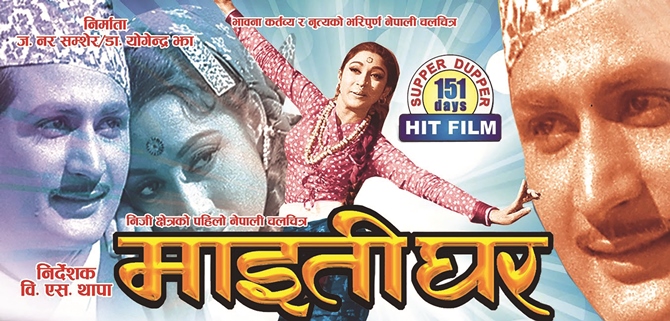Nepali Movies then and now

By Renuka Dhakal
Kathmandu, Apr. 11: History of Nepali cinema is not long. The first Nepali language movie was Satya Harischandra directed by DB Pariyar which was released in 1951. The movie was produced in Kolkota, India.
The first film produced in Nepal was Aama (Mother) by the Information Department in 1964. It was directed by Hira Singh Khatri.
The first Bollywood movie Raja Harischandra , a silent film by Dadasaheb Phalke was released in 1913, almost 38 years before the making of first Nepali movie. Indeed, the story of the first films of both Bollywood and Kollywood was about King Harischandra Even now, Nepali films have been blamed for being inspired by Bollywood films.
The Nepali feature film Maitighar was the first movie produced under the private banner. It was released in 1966. Mala Sinha and Chitamber Prasad Lohani were key actors of this movie.
The government had played an important role for the development of films in Nepal. The government had established the Royal Nepal Film Cooperation in 1971, and Man Ko Baadha was the first feature film produced from the corporation in 1973. Then it produced Kumari, the first colour film in 1977. Kumari was directed by Prem Bahadur Basnet.
The early films are still popular among the Nepali audiences due to their natural story and simple and clear narratives. Movies like Sindoor, Jeevan Rekha, Badlido Aakash and Paralko Aago were some of the movies made before 1990, and these films still touch the hearts of Nepali audiences.
“I have watched “Sindoor” and “Jeevan Rekha” more than five times, and every time I watch these films I like them,” said Menuka Baskota . She said that these films simply portrayed the vibrant picture of our society with simplicity. Nepali cinema had become popular among audience since 1990. With the end of the Panchayat system and the restoration of democracy after the People's Movement of 1990, the popularity of Nepalese films increased with an increase in their audience.
Actors like Bhuvan KC, Tripti Nadkar, Rajesh Hamal, Karisma Manandhar, Haribansha Acharya, Mandan Krishna Shrestha and Shiva Shrestha were famous artistes of that time, and many of them are equally popular today.
Unfortunately, with the armed insurgency waged by the Maoists in 1996, the Nepali film industry witnessed a greatest shortfall. Halls were shut down. Established producers and filmmakers hesitated to continue their career. As a result, quality of the film declined and Neaplis developed a negative attitude towards the entire Nepali film industry.
After the end of the conflict in 2006, the situation gradually improved and learned filmmakers joined the industry, producing better films.
The biggest change was noticed after the making of Loot in 2012. It helped change the course of the Nepali film industry. Written and directed by Nichal Basnet, Loot had collected Rs. 52 million, the record highest amount till then.
Likewise, “Kohinoor” with the lead of late Shree Krishna Shrestha, “Kabadi Kabadi” “Chakka Panja” series, and “Kalo Pothi” a critically acclaimed movie, were some of the best and commercially successful movies produced in the past seven years.
Nepali films have always been lacking young audience. However, with the rise of technology, social media and new generation artistes like Anmol KC, Pradeep Khadka, Samragyee RL Rana and others, young generation people have started showing interest to Nepali movies, and it should be taken as a positive sign for the development of the local film industries. Besides, the youth have, of late, been exploring stories of indigenous people in movies.
Recent News

Do not make expressions casting dout on election: EC
14 Apr, 2022
CM Bhatta says may New Year 2079 BS inspire positive thinking
14 Apr, 2022
Three new cases, 44 recoveries in 24 hours
14 Apr, 2022
689 climbers of 84 teams so far acquire permits for climbing various peaks this spring season
14 Apr, 2022
How the rising cost of living crisis is impacting Nepal
14 Apr, 2022
US military confirms an interstellar meteor collided with Earth
14 Apr, 2022
Valneva Covid vaccine approved for use in UK
14 Apr, 2022
Chair Prachanda highlights need of unity among Maoist, Communist forces
14 Apr, 2022
Ranbir Kapoor and Alia Bhatt: Bollywood toasts star couple on wedding
14 Apr, 2022
President Bhandari confers decorations (Photo Feature)
14 Apr, 2022











